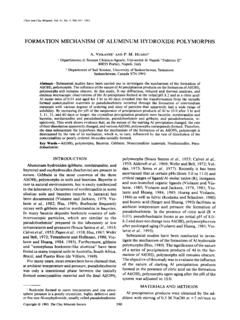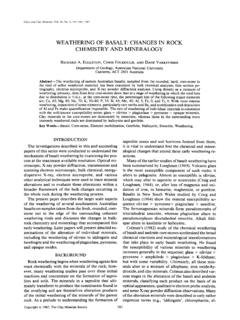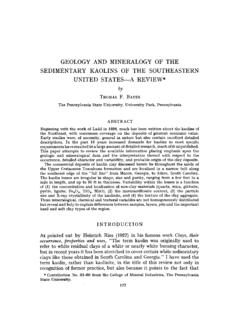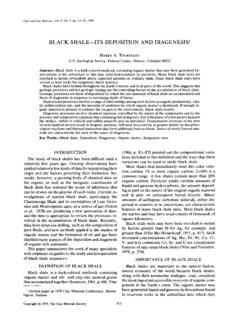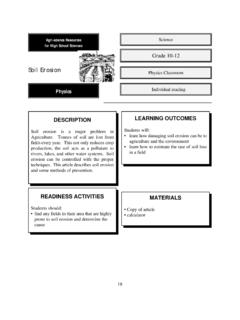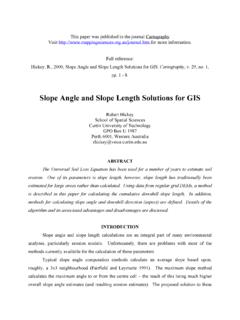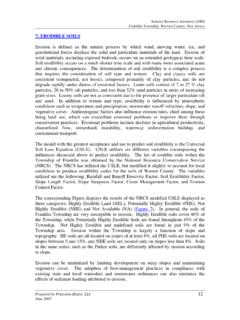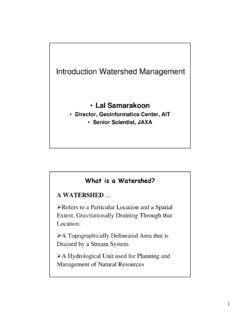Transcription of SWELLING CHARACTERISTICS OF COMPACTED, …
1 Clays and Clay Minerals, 1971,Vol. 19,pp. 251-261. Pergamon Press. Printed in Great Britain SWELLING CHARACTERISTICS OF compacted , expansive SOILS. N. V. NAYAK and R. W. CHRISTENSEN. Department of Engineering Mechanics, Engineering Building, The University of Wisconsin, Madison, Wisc. 53706. (Received 5 November 1970). Abstraet-The limitations of existing methods for the prediction of SWELLING behavior of compacted softs are examined. Both the purely theoretical approach and the purely empirical approach are found to be inadequate. The present study is based on a semi-empirical approach in which a model of SWELLING behavior is developed leading to equations relating SWELLING potential or SWELLING pressure of a compacted soil to its plasticity index, clay content and initial molding water content. The model is based on the concepts of the diffuse double layer, modified by introducing empirical constants to account for elastic SWELLING effects and other limitations involved in the direct application of double layer theory to real soils.
2 The empirical constants are evaluated from the results of experimental investigations carried out on a large number of soil samples representing a wide variation of clay content as well as consistency limits. It is shown that the predicted values of the SWELLING potential and SWELLING pressure based on the proposed model agree closely with the experimental results of this study and those reported in the literature. Furthermore, the equations developed in this study are of a more general nature and appear to be applicable to a larger range of soil types than those previously published. INTRODUCTION which are well understood by engineers. These CONSIDERABLE research has been done in an empirical equations are easy to apply and give attempt to understand the basic mechanisms invol- satisfactory results when applied to the particular ved in SWELLING of expansive soils. Theories based soils for which they were developed.
3 However, on physico-chemical considerations have been the empirical approach also has its limitations. F o r developed to explain swell or swell pressure example, the equations are based purely on the CHARACTERISTICS of pure clay suspensions. To a results of the experimental investigations conducted certain extent experimental verification of these on a limited number of soil samples; it remains to theories has been obtained (see for example Bolt, be seen whether these equations give satisfactory 1956; Yong et al., 1962). However, there are results when applied to other soils. Furthermore, certain important limitations in applying these there is no theoretical basis to support the validity theories to natural or compacted soils. F o r example, of the particular form of equation used. these theories fail to account for the complexities of In the present investigation semi-empirical natural or compacted soils because of several relationships are developed to predict SWELLING simplifying assumptions made in them.
4 Also, in behavior of compacted , expansive soils. The basic spite of the simplifying assumptions these theories forms of the relationships are derived from theoret- are still mathematically complex and difficult to ical considerations of the diffuse double layer and apply to engineering practice. the osmotic pressure for parallel clay plates. To Recently greater attention has been given to bridge the gap between the idealized soil system empirical investigations of the SWELLING behavior used in the theoretical considerations and the real of compacted and natural soils (Holtz and Gibbs, soil system, empirical constants are introduced as 1956; Ladd, 1960; Seed et al., 1962; Ranganatham modifications to the basic theoretical relationships. and Satyanarayan, 1965; Nalezny and Li, 1967; These empirical constants are evaluated from Sowers and Kennedy, 1967; Komornik and David experimental investigations carried out on a large 1969).
5 A s a result of these investigations, various number of soil samples representing a wide varia- forms of empirical equations have been proposed tion in clay content and consistency limits. The which relate SWELLING behavior to certain physical resulting semi-empirical equations relate SWELLING properties of soils, such as consistency limits, clay behavior of a compacted soil to its clay content, content, initial moisture content and density, plasticity index and initial molding water content. 251. 252 N . V . NAYAK and R. W. CHRISTENSEN. PREVIOUS INVESTIGATIONS Equation (1) provides a more accurate prediction The analytical approach to the prediction of of SWELLING potential of compacted softs than equa- SWELLING pressure in soils is based on the osmotic tion (2) but Seed et al. suggest that equation (2). pressure developed between clay plates (Bolt, may be best suited for practical purposes because 1956; Nalezny and Li, 1967; Mitchell, 1969).
6 It relates the single parameter, plasticity index, to However, in soils, osmosis occurs without the SWELLING potential. The authors show that the loss physical existance of a semipermeable membrane of accuracy involved in using equation (2) instead and the conditions inducing osmosis are different of equation (1) will not exceed +-33 per cent for than the "ideal" conditions assumed in deriving natural soils with clay contents ranging from 8 per the equation for osmotic pressure (Ruiz, 1962). cent to 65 per cent. They also found that shrinkage Furthermore, in order to estimate the osmotic limit cannot be correlated with the SWELLING pressure it is necessary to determine the cation potential. concentration at the mid-plane between the Ranganatham and Satyanarayan (1965) who particles. Solutions for cation concentration at the carried out SWELLING potential studies on four mid-planes between the clay plates are available natural soils found that either swell activity (ratio for some simple cases only, and, at any rate, it is of change in shrinkage index to the corresponding difficult to evaluate the cation concentration change in clay content) and clay content or shrink- accurately for natural or compacted soils.
7 Age index alone correlate better with SWELLING In equating the osmotic pressure to the SWELLING potential of compacted softs. Thus, Ranganatham pressure of a soil , the effects of elastic rebound, and Satyanarayan (1965) propose an equation of pressure in entrapped air bubbles, and the forces the form, of attraction are neglected. In some soils, including compacted clays, SWELLING due to these effects S = ml (SI) 2"67 (3). can be significant. Although there have been attempts to account for the attractive forces (Ruiz, where, 1962; Nalezny and Li, 1967), in general, these mt = constant theoretical equations for the prediction of SWELLING -- , for natural soils or SWELLING pressure are far from satisfactory for S I = shrinkage index (liquid limit-shrinkage limit). use with natural or compacted soils. as a percentage. Recently there have been several attempts to develop empirical relationships to predict SWELLING Ranganatham and Satyanarayan report that or SWELLING pressure of softs.
8 Extensive experiment- equation (3), predicts SWELLING potential within al investigation by Seed et al. (1962) on artifically ---34 per cent. However, when equation (3) is prepared, compacted soils indicated that, for a applied (by the writers) to soils studied by Seed given type of clay mineral, the SWELLING potential* et al., the errors in the calculated values of SWELLING of a soil , S, is related to its activity, A, and clay potential are found to be quite large, indicating content, C, by the equation, that equation (3) as proposed by Ranganatham and Satyanarayan is also not applicable to compacted S = k(A 2"44)(C 3"44) (1) soils in general. Sowers and Kennedy (1967), who studied the where, SWELLING behavior of undisturbed natural soils, k = a constant for all types of clay mineral indicate that swell pressure and SWELLING potential 3-6 10-5. can best be related to the water plasticity ratio which is defined as the ratio of water content minus Seed et al.
9 Also report that plasticity index (PI) plastic limit to plasticity index. However, in the is the single best factor to predict SWELLING potential case of SWELLING pressure versus water plasticity of soils. The form of the equation in terms of ratio, there is a wide scatter of the data points. plasticity index is, Komornik and David (1969) carried out SWELLING pressure tests on a number of natural (undisturbed). S = (k) ( M ) ( ) (2) soft samples and, on the basis of statistical (regres- sion) analysis, developed the following relationship: where, M = constant log (P) = + 0-0208 ( L L ) + (Ya). = 60 for natural soils -- 0-0269 ( w ) (4). = 100 for artificial soils. where, *Per cent vertical strain under 1 psi surcharge. P = SWELLING pressure in kg/cm 2. compacted , expansive SOILS 253. L L = liquid limit optimum moisture content corresponding to the ~/a = dry density of soil sample in kg/m 3 standard A A S H O compaction test is relatively w = water content.
10 Constant. A s a first approximation the SWELLING pressure Komorik and David obtained a coefficient of may be equated to its osmotic pressure as expres- correlation of for log (P) with the parameters sed by the van't Hoff equation with the concentra- in equation (4); liquid limit, density and mois- tion of cations at the central plane between particles t u r e content. However, the coefficient of correla- as predicted by the Langmuir equation (Yong and tion decreased to when log (P) was related to Warkentin, 1966): only two quantities, liquid limit and density. The coefficient of correlation was further reduced R T ~r2. to when log (P) was related to liquid limit *P = Pos = R T c c = z ~ ( d + xo)Z(lO_16 ) (5). alone. Nevertheless, the authors state that liquid where, limit is best as a single variable in the prediction of SWELLING pressure of soils. P ---- SWELLING pressure The preceding empirical equations give reason- Po, = osmotic pressure ably good results when applied to the particular R = universal gas constant soils for which they were developed.

